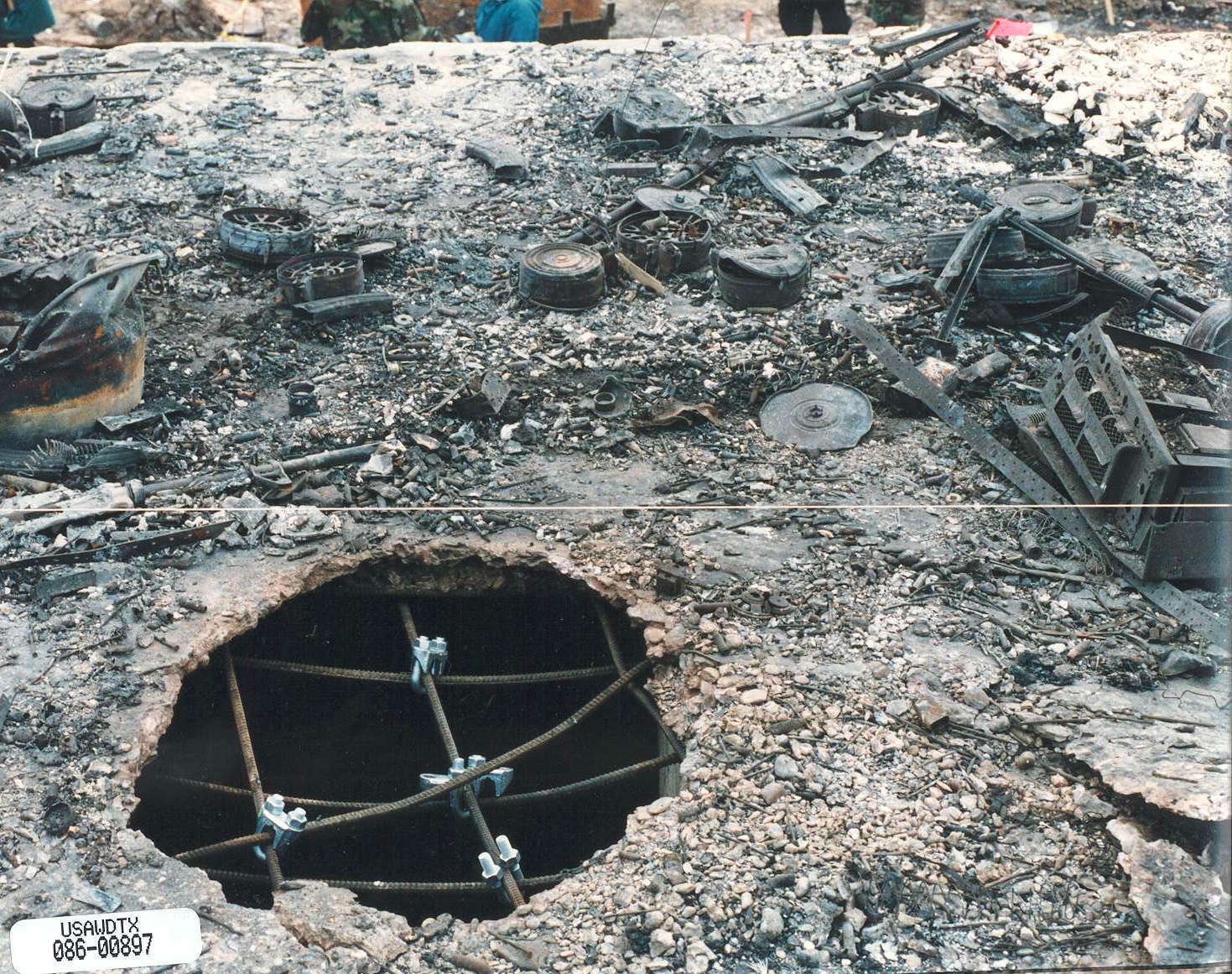 One phenomenon never explained by the government reports was the 18-24 inch hole breached through reinforced concrete in the top of the concrete room. Whatever caused the hole would have killed anyone inside, not from "falling debris," but from concussion and concrete shards propelled like shrapnel. The photo is tagged with a "USAWDTX" identifier, indicating the source is the US Attorney for the Western District of Texas. Click to enlarge. |
In the previous exhibit, we saw that Sgt. Coffman noticed a hole in the ceiling of the concrete room and attributed its presence to an explosion. We have also seen references to an explosion in several Autopsy Reports (see page 4 of Mt. Carmel 31 A and page 1 of Mt. Carmel 69).
If the hole was caused by an explosion, it was forceful enough to knock an 18-24 inch hole in 6-inch steel-reinforced concrete (see US News & World Report, May 3, 1993 and Newsweek, May 3, 1993). The curvature of the exposed rebar indicates the force came from above, and not from the supposed ammunition fire below. See this close-up photo, donated to the Museum by an unofficial source. Note the red flag, marking the location of a body.
In the room beneath that hole, some 33 to 43 human bodies were found. Any explosion that could have caused that hole, and the effect it would have on either the dead or the living beneath it, is something that should have piqued the interest of "one of the finest forensic sleuths of our time," Dr. Douglas Ubelaker, curator of anthropology of the Smithsonian Institution. It also should have piqued the interest of the FBI, the redoubtable Texas Rangers, and the other medical examiners.
But no such curiosity was in evidence. The report from the Department of Justice (parent organization to FBI) does not mention the hole. A number of casualties are attributed to "suffocation" or "was buried alive," but there is no detail concerning the circumstances of suffocation and burial. In the pages summarizing the autopsy reports (DoJ Report, pg. 311), under the heading "Judy Schneider" are the words: "Judy Schneider was buried alive when the bunker collapsed. She died of suffocation. She was identified from fingerprints. She was 41 years old." (DoJ Report, Pg. 315)
What would be the effect on living people if such a powerful explosion were detonated over their heads? Some might be injured or killed as a result. "Suffocation" and "buried alive" would hardly describe the effects of that explosion. "Blunt force trauma" may describe the proximal cause of death, but the manner of death should definitely include mention of a nearby concussion of that magnitude.
Instead, the benign term "structural collapse," is repeated in the Autopsy Reports. Dr. Peerwani carried the story into the 1994 San Antonio trial with his testimony. But there is little discussion of what might have caused the "collapse."
As discussed earlier, collapse is not slow erosion over time. Collapse is sudden and relatively brief.
The American Heritage Dictionary definition: "1. The act of falling down or inward, as from loss of supports. 2. An abrupt failure of function, strength, or health; breakdown."
Note that "collapse" does not describe the effect on a concrete slab when a bomb punches a hole in it, unless the slab subsequently falls "from loss of supports." Collapse describes the inherently passive action of a falling structure or body. It does not describe a structure battered to the earth by explosive force.
We notice that our attention is called to the gruesome remains in the concrete room, but we are expected to ignore the hole in the ceiling. In this case, deliberate avoidance of the subject is suspicious: In the presence of murder, the motive for hiding evidence is often to avoid incrimination. If the explosion in the roof could have been caused by Davidian armaments detonating in the fire, mention in the autopsies would have been appropriate. Moreover, the rebar would be bowed upward from the explosion, rather than downward as the photograph shows (top of this page).
So why did the medical examiners leave the explosion and the hole out of their reports? Once again, evasion of fact arouses suspicion: We might infer that US Special Operations or FBI/HRT commandos prepared and detonated the destructive device that damaged the roof. The story of "bunker collapse" was prepared in advance to launder the bodies and disguise evidence of death by other causes, in other places, at different times. Perhaps the device was intended to bring tons of concrete raining down on the bodies inside, obliterating evidence of anything else. But when the device was detonated, it failed to make the room collapse, and the game was too advanced, with too many people involved to concoct a new cover story.
And now the whole squad comes across as credible as the singer in that country and western song: "… and I can't prove it, but that's my story and I'm stickin' to it …"
Recall that the concrete room was bulldozed within two weeks of the fire (">The Dallas Morning News, May 1, 1993). Why would anyone so brazenly destroy key evidence, unless it was incriminating to themselves?